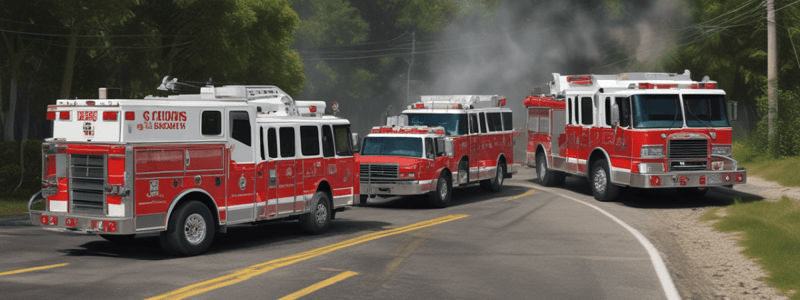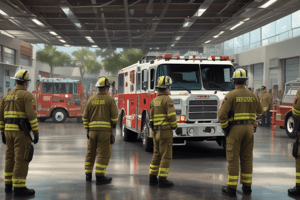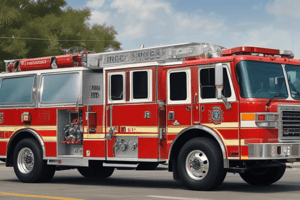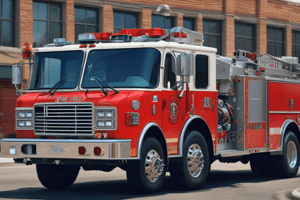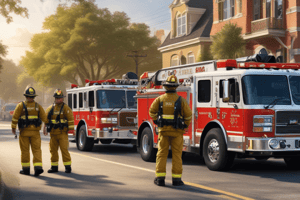Podcast
Questions and Answers
What is the primary purpose of the policy described in the text?
What is the primary purpose of the policy described in the text?
- To define the organizational plan for effectively triaging, treating, and transporting patients in multiple casualty incidents (correct)
- To establish guidelines for responding to large scale disasters
- To outline the responsibilities of the first arriving unit's officer in an MCI situation
- To provide a comprehensive overview of the START triage system
What is the first action the officer of the first arriving unit should take according to the procedure?
What is the first action the officer of the first arriving unit should take according to the procedure?
- Perform a size-up (correct)
- Direct crew members to initiate triage
- Request additional units and specialized equipment
- Identify a staging area
Which of the following is NOT a triage category mentioned in the text?
Which of the following is NOT a triage category mentioned in the text?
- Delayed
- Critical (correct)
- Ambulatory (minor)
- Immediate
What is the purpose of locating and removing the walking wounded to a separate location?
What is the purpose of locating and removing the walking wounded to a separate location?
According to the procedure, what is the officer of the first arriving unit responsible for requesting?
According to the procedure, what is the officer of the first arriving unit responsible for requesting?
What is the purpose of using the color-coded ribbons found in the MCI bag?
What is the purpose of using the color-coded ribbons found in the MCI bag?
What is the responsibility of the TREATMENT OFFICER at an MCI scene?
What is the responsibility of the TREATMENT OFFICER at an MCI scene?
What should the first arriving units do to establish command/control at an MCI scene?
What should the first arriving units do to establish command/control at an MCI scene?
What is the primary role of the MEDICAL BRANCH during an MCI?
What is the primary role of the MEDICAL BRANCH during an MCI?
Why is the consideration of private ambulance services mentioned in the text for managing MCIs?
Why is the consideration of private ambulance services mentioned in the text for managing MCIs?
During large scale or complex MCI's, what should be done to reduce span of control according to the text?
During large scale or complex MCI's, what should be done to reduce span of control according to the text?
What should the TRIAGE OFFICER do upon completion of triaging duties at an MCI scene?
What should the TRIAGE OFFICER do upon completion of triaging duties at an MCI scene?
Why might the use of Mobile Command Vehicles (MCV) or Triage Trailers be considered in managing MCIs?
Why might the use of Mobile Command Vehicles (MCV) or Triage Trailers be considered in managing MCIs?
What does COMMAND do during large-scale or complex MCI's?
What does COMMAND do during large-scale or complex MCI's?
What should Fire Rescue Communications do upon contacting hospitals during an MCI?
What should Fire Rescue Communications do upon contacting hospitals during an MCI?
Why is it crucial for TREATMENT OFFICERS to re-triage patients after initial assessment at an MCI?
Why is it crucial for TREATMENT OFFICERS to re-triage patients after initial assessment at an MCI?
What does the START method of triage aim to achieve?
What does the START method of triage aim to achieve?
What should be done if borderline triage decisions are encountered?
What should be done if borderline triage decisions are encountered?
What information does the TRANSPORT provide to Fire Rescue Communications?
What information does the TRANSPORT provide to Fire Rescue Communications?
What is the role of the STAGING OFFICER during an incident?
What is the role of the STAGING OFFICER during an incident?
What should personnel do according to the protocol during an incident?
What should personnel do according to the protocol during an incident?
How should triage decisions be made using the START Method?
How should triage decisions be made using the START Method?
What should Fire Rescue Communications do during an incident requiring high medical resource demand?
What should Fire Rescue Communications do during an incident requiring high medical resource demand?
What is one responsibility of a Documentation Aide assigned by TRANSPORT?
What is one responsibility of a Documentation Aide assigned by TRANSPORT?
Why should ground transported patients be assigned to hospitals on a rotating basis?
Why should ground transported patients be assigned to hospitals on a rotating basis?
What role does Fire Rescue Communications play in coordinating patient transportation during incidents?
What role does Fire Rescue Communications play in coordinating patient transportation during incidents?
What should be done if a patient is identified as Red during initial triage and transport is available?
What should be done if a patient is identified as Red during initial triage and transport is available?
What should be done with the walking wounded patients?
What should be done with the walking wounded patients?
What is the mnemonic used to remember the order of assessment during triage?
What is the mnemonic used to remember the order of assessment during triage?
If a patient's respiratory rate is over 30/min, what triage tag should be assigned?
If a patient's respiratory rate is over 30/min, what triage tag should be assigned?
How is perfusion assessed during triage?
How is perfusion assessed during triage?
If a patient follows commands and is oriented to time, place, and person, what triage tag should be assigned?
If a patient follows commands and is oriented to time, place, and person, what triage tag should be assigned?
What should be done if the first assessment produces a Red tag?
What should be done if the first assessment produces a Red tag?
What should be done for children less than one year of age during triage?
What should be done for children less than one year of age during triage?
What is the AVPU scale used for during triage?
What is the AVPU scale used for during triage?
If a patient has a respiratory rate of 15-45/min and a palpable peripheral pulse, what triage tag should be assigned?
If a patient has a respiratory rate of 15-45/min and a palpable peripheral pulse, what triage tag should be assigned?
What is the role of the officer designated as TRIAGE?
What is the role of the officer designated as TRIAGE?
What is the minimum number of suppression units required for an MCI Level 2 incident?
What is the minimum number of suppression units required for an MCI Level 2 incident?
What is the primary responsibility of the officer designated as TRANSPORT?
What is the primary responsibility of the officer designated as TRANSPORT?
Which of the following is NOT one of the additional officer positions that may be required depending on the complexity of the incident?
Which of the following is NOT one of the additional officer positions that may be required depending on the complexity of the incident?
How many hospitals will Fire Rescue Communications contact to determine status and patient capacity for an MCI Level 3 incident?
How many hospitals will Fire Rescue Communications contact to determine status and patient capacity for an MCI Level 3 incident?
What is the minimum number of ALS transport units required for an MCI Level 4 incident?
What is the minimum number of ALS transport units required for an MCI Level 4 incident?
Which of the following is NOT a responsibility of the officer designated as STAGING?
Which of the following is NOT a responsibility of the officer designated as STAGING?
What is the primary role of the officer designated as TREATMENT?
What is the primary role of the officer designated as TREATMENT?
How many Battalion Chiefs are required for an MCI Level 3 incident?
How many Battalion Chiefs are required for an MCI Level 3 incident?
What is the primary responsibility of the officer designated as LANDING ZONE?
What is the primary responsibility of the officer designated as LANDING ZONE?
Flashcards are hidden until you start studying
Study Notes
MCI Response Plan
- Purpose: Define the organizational plan to effectively triage, treat, and transport patients in multiple casualty incidents (MCI's).
Command Structure
- COMMAND officer establishes command and performs a size-up
- Requests a Level 1, 2, or 3 response based on the number of patients
- Requests additional units and/or specialized equipment as required
- Identifies a staging area
- Directs crew members to initiate triage using START method
Triage and Treatment
- Triage uses color-coded ribbons to identify victim status:
- Red: Immediate
- Yellow: Delayed
- Green: Ambulatory (minor)
- Black: Deceased (non-salvageable)
- Walking wounded are removed to a separate location and assessed as soon as possible
- TREATMENT officer:
- Completes a "Treatment Officer Log"
- Assigns a "Documentation Aide" to assist with paperwork
- Ensures all patients are re-triaged through a secondary exam
- TRANSPORT officer:
- Assigns a "Documentation Aide" to assist with paperwork and communications
- Coordinates transportation of patients to hospitals
MCI Levels
- Level 1: 5-10 patients
- 4 ALS transport units
- 1 Battalion Chief and 2 suppression units
- Level 2: 11-20 patients
- 6 ALS transport units
- 2 Battalion Chiefs and 3 suppression units
- Level 3: 21-100 patients
- >8 ALS transport units
- 2 Battalion Chiefs and >4 suppression units
- Level 4: 101-1000 patients
- >10 ALS transport units
- >2 Battalion Chiefs and >6 suppression units
START Triage Method
- Assess RESPIRATIONS:
- Respiratory rate >30/min: Tag Red
- Respiratory rate ≤30/min: Go to PERFUSION assessment
- Assess PERFUSION:
- Radial pulse present or capillary refill ≤2 seconds: Go to MENTAL STATUS assessment
- No radial pulse or capillary refill >2 seconds: Tag Red
- Assess MENTAL STATUS:
- Patient follows commands and is oriented: Tag Green
- Patient does not follow commands or is disoriented: Tag Red
JumpSTART for Pediatrics
- Ages 1-8 years old
- Assess BREATHING:
- Spontaneously breathing: Go to RESPIRATORY RATE assessment
- Apneic or irregular breathing: Open airway and assess for peripheral pulse
- Assess RESPIRATORY RATE:
- Respiratory rate 15-45/min: Go to PERFUSION assessment
- Respiratory rate >45/min or irregular: Tag Red
- Assess PERFUSION:
- Peripheral pulse present: Go to MENTAL STATUS assessment
- No peripheral pulse: Tag Red
- Assess MENTAL STATUS:
- Patient responds to verbal commands or pain: Tag Green
- Patient does not respond to verbal commands or pain: Tag Red
Studying That Suits You
Use AI to generate personalized quizzes and flashcards to suit your learning preferences.
